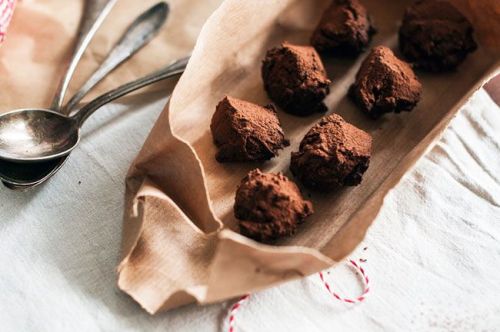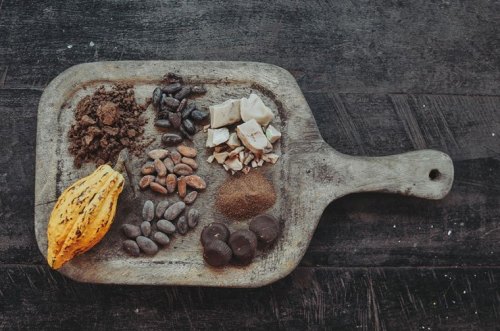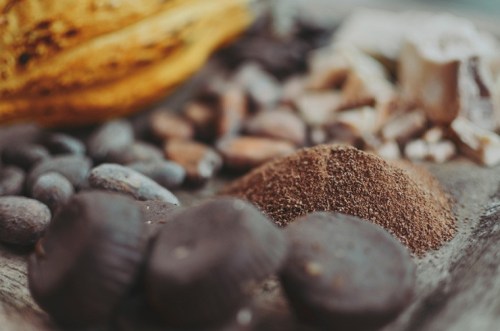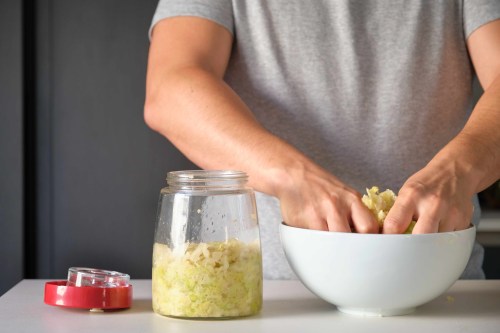Cacao is trending right now—but is it actually healthy?
Top Balance Nutrition founder Maria Bella, MS, RD, CDN, explains the nutritional benefits of cacao and how to shop for healthy chocolate.

Ask pretty much any wellness pro how she satisfies her sweet tooth, and chances are you’ll get a five-letter word in return: cacao.
The ultra-pure precursor to chocolate isn’t just tasty—it’s such a mood-booster that some people are even getting high off it. Brands are wising up to its perks, too. Last year at ExpoEast, one of the biggest healthy food and drink conferences, Cacao Juice was the talk of the convention center. And Freaky Chocolate‘s adaptogenic bars—AKA the healthiest candy ever—tout a whopping 79 percent cacao content without any added sugar (they’re sweetened with just mulberries).
But there’s a big difference between raw cacao and the chocolate you’re used to snacking on as a treat. So when, exactly, does cacao transition from being a nutrient-dense superfood into dessert? Any how much is actually healthy?
I tapped Top Balance Nutrition founder Maria Bella, MS, RD, CDN, for the non-sugar-coated lowdown on everything you need to know about the buzzy ingredient.
Here’s the truth about whether cacao is really healthy.

Starting out strong
First, a botany lesson. “Cacao trees produce cacao pods, which are cracked open to release cacao beans, which can be processed in different ways,” Bella says. She explains that the beans are very high in minerals—magnesium, potassium, iron, and zinc are all inside—and they’re a good source of fiber, healthy fat, and protein. (They’re also rich in brain-boosting flavanols.)
When the beans are ground up to make cacao powder, they maintain that same array of of nutrients. Cacao nibs—essentially the beans, chopped up into edible pieces—are healthy, too. “They’re like little pieces of chocolate, without all the sugar,” Bella explains.
And what about cacao butter, which is used to make white chocolate? “That comes from the fattiest part of the fruit, making up the lining of the cacao bean,” she says. It, too, starts out as a nutritional powerhouse.
In this form, cacao is at its healthiest. It hasn’t been roasted, processed, or treated in any way. So if you see “raw cacao” on the label of a chocolate bar, it’s definitely a good thing.

What about chocolate?
Get this—cacao, in its pure form, has zero sugar. Zero.
But once the process that transforms it into chocolate begins, that all changes. “Chocolate made from cacao has sugar added to it,” Bella explains. So if you’re trying to avoid the sweet stuff, look at the nutrition label before buying a chocolate snack. The higher the cacao percentage, the lower the sugar content should be.
Chocolate’s nutritional value also depends upon its pure cacao content. For example, read any article claiming chocolate is “healthy” and you’ll surely come across a line about how it’s high in antioxidants. Bella says this is true, but keep in mind that the darker the chocolate—and the higher its percentage of cacao—the more antioxidants actually contains.
So what’s the final verdict? According to Bella, raw cacao is, in fact, good for you. It’s the processed chocolate with added sugar that does the body more harm than good. “Like any food, have cacao in moderation,” she advises. “But adding a teaspoon of cacao powder to your morning smoothie or cacao nibs to your oatmeal will give you a good boost of nutrients.” You don’t have to tell me twice.
Speaking of cacao smoothies, here’s how to make the mint-chip superfood shake of your dreams. Or whip up one of these 5-ingredient, low-sugar desserts.








